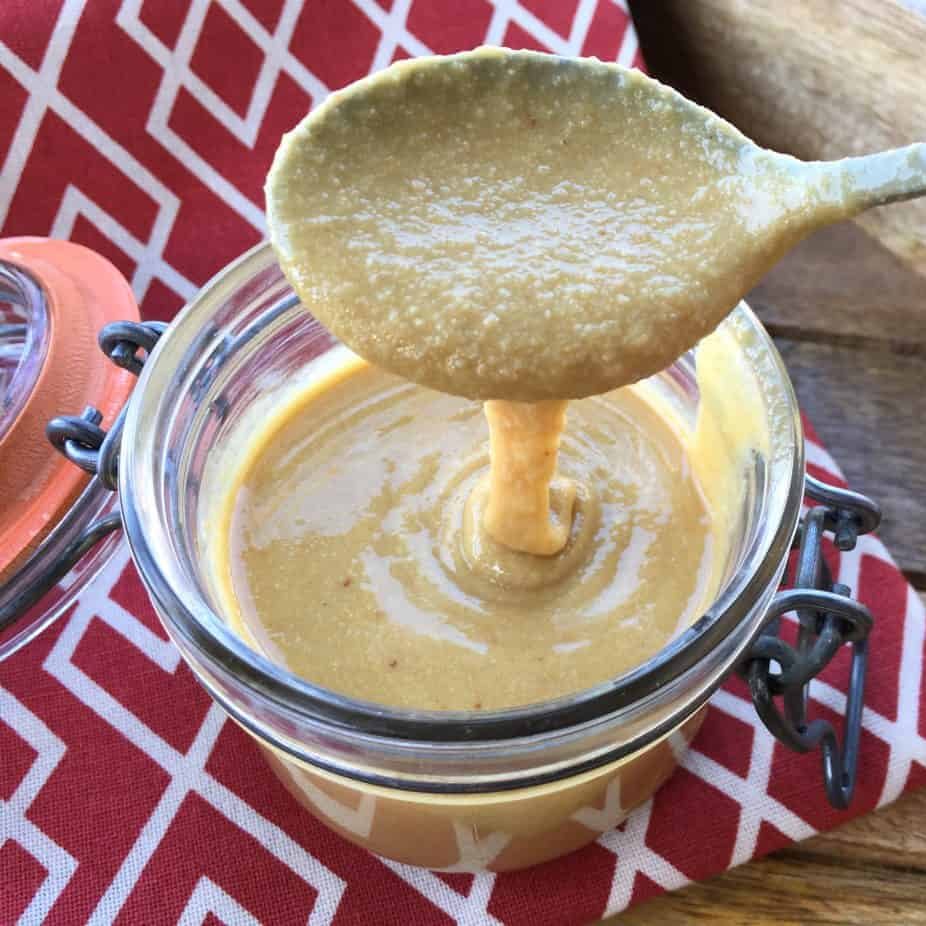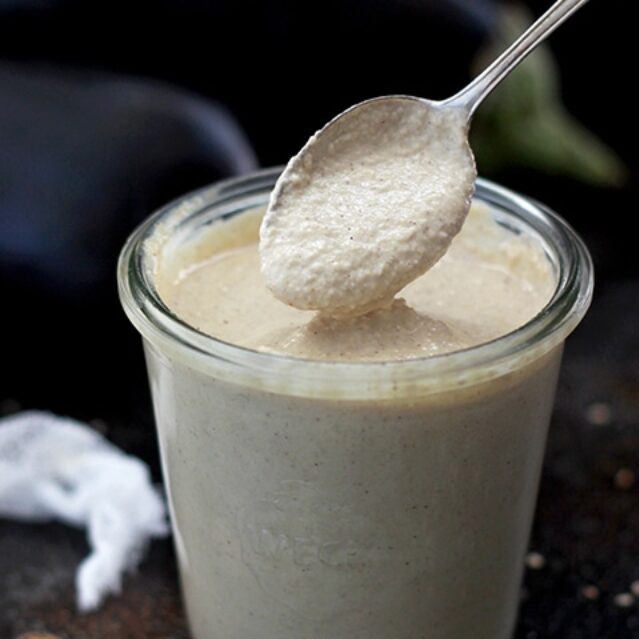Essential Ingredients for Homemade Tahini
To make a delicious tahini paste at home, only a few key ingredients are necessary.

Key Ingredients and Substitutes
At the heart of every tahini paste is sesame seeds, which are non-negotiable. Choose white hulled sesame seeds for a classic tahini. Alternatively, use unhulled seeds for a more bitter, nutrient-rich option. Olive oil is another critical component, but you can substitute it with any neutral oil to alter the flavor subtly.
Importance of Sesame Seed Quality
The quality of sesame seeds greatly impacts the taste and texture of your tahini. Opt for high-quality, fresh sesame seeds. Ensure they are free from moisture to avoid spoilage and achieve the best results in flavor and consistency when blended.
Step-by-Step Blender Method
Making tahini paste at home is a straightforward process with your trusty blender. To ensure success, follow these steps carefully.
Preparing the Sesame Seeds
Before you begin blending, it’s essential to prepare the sesame seeds properly. Start by measuring out 300g, or approximately 2 cups, of white hulled sesame seeds. Lightly toast them in a dry skillet over medium heat. Keep them moving to prevent burning. Once they develop a fragrant, nutty aroma and turn slightly golden, take them off the heat. Let them cool down completely before blending, as warm seeds can create an undesired paste consistency.
Blending to Perfect Consistency
Once your sesame seeds are cooled, place them into your blender. It’s best to use a blender with a powerful motor and sharp blades for a smooth paste. Begin blending on a low to medium speed. If your blender has a nut mode, use it to your advantage. Apply downward pressure using a tamp or pusher to ensure all seeds come into contact with the blades. Blend until the oils start to release and form a smooth paste. Be patient, as this may take several minutes. Stop the blender occasionally to scrape down the sides. For a thinner tahini, gradually add extra virgin olive oil while blending on a smoothie setting. Continue to add oil until you reach the texture you desire. Your homemade tahini is now ready to use or store for later enjoyment.
Flavour Enhancements for Your Tahini
Creating your own tahini paste at home doesn’t stop at achieving the right consistency. The beauty of homemade tahini lies in the ability to personalize its flavor. By adding a variety of oils and seasonings, you can transform your tahini into a unique component for numerous dishes.
Adding Oils and Seasonings
Olive oil is the classic choice for tahini, and for good reason. It provides a smooth texture and complements the nutty taste of sesame seeds. But don’t hesitate to experiment with other oils for different nuances in flavor. Try avocado oil for a buttery note or grapeseed oil for a lighter taste. When it comes to seasonings, a pinch of salt can enhance the natural flavor profile of your tahini. If you’re adventurous, spice it up with a dash of cumin or garlic powder.
Experimenting with Sweet and Savory Variants
Tahini isn’t limited to savory dishes. Sweet tahini is quickly gaining popularity. Stir in a spoonful of honey or maple syrup to create a sweet spread perfect for toast. For a savory twist, blend in roasted red peppers or herbs like parsley and cilantro. These sweet and savory variants make tahini versatile, ensuring it’s not just for traditional Middle-Eastern recipes, but a staple that can cross over into countless cuisines.
Preserving Fresh Tahini
Once you have made your fresh tahini paste using a blender, proper preservation is key to maintaining its quality and flavor. Here are some practical tips for storing your tahini effectively and understanding its shelf life and usage.
Storage Tips
To ensure the longevity of your homemade tahini, follow these storage guidelines:
- Use the Right Container: Store your tahini in a clean, airtight container. Glass jars are ideal because they don’t absorb flavors and are easy to sterilize.
- Refrigerate: Keep your tahini in the refrigerator. This keeps it fresh and slows down the oil separation process.
- Keep it Dry and Sealed: Make sure the lid is tightly sealed. Exposure to air can spoil the tahini faster.
- Avoid Contamination: Use a clean spoon each time you scoop out tahini to prevent introducing any contaminants.
Shelf Life and Usage
Understanding the shelf life and various uses of tahini can help you plan better and enjoy your homemade condiment to the fullest:
- Shelf Life: When stored properly, homemade tahini can last up to a month in the refrigerator. If you notice any off smells or mold, discard the tahini immediately.
- Culinary Uses: Tahini isn’t just for hummus! Use it in dressings, sauces, or even marinades to add a creamy, nutty flavor to your dishes.
- Check Consistency Before Use: Sometimes, oil can separate on the top. Stir the tahini well before using it to get back to the right consistency.
By following these storage tips and understanding usage, you can ensure your homemade tahini stays fresh and delicious, ready to enhance any dish you prepare.
 Common Mistakes and Troubleshooting
Common Mistakes and Troubleshooting
While making tahini paste at home using a blender is generally straightforward, there are common errors that can affect the final product. Knowing how to troubleshoot these mistakes can help you achieve the perfect tahini every time.
Avoiding Over-Processing
One of the key errors in making tahini is over-processing the sesame seeds. When blended too long, the seeds can turn into an overly thick and bitter paste. To avoid this:
- Monitor the blending process closely.
- Stop the blender every few minutes to check the consistency.
- Blend in short bursts and use the ‘pulse’ feature if available.
Adjusting Texture and Taste
The texture and taste of tahini can vary based on a few factors. If your tahini is too thick or lacks flavor, consider these adjustments:
- For a thinner consistency, gradually add more olive oil while blending.
- If the tahini tastes too bitter, ensure you are using fresh, high-quality sesame seeds.
- Balance the taste with a pinch of salt or a dash of lemon juice.
By keeping these troubleshooting tips in mind, you can refine your technique and create delicious, homemade tahini perfect for a variety of dishes.
 Creative Uses of Homemade Tahini
Creative Uses of Homemade Tahini
Homemade tahini isn’t just a dip or spread. Its versatility in cooking is vast and exciting. From enhancing flavors in Middle-Eastern dishes to adding a unique twist to Western recipes, homemade tahini can elevate ordinary meals to extraordinary culinary experiences.
Culinary Applications in Middle-Eastern Dishes
Tahini is a fundamental ingredient in Middle-Eastern cuisine. Let’s explore how you can use your homemade tahini in traditional and innovative ways:
- Hummus: Blend tahini with chickpeas, lemon juice, and garlic for a creamy hummus.
- Baba Ganoush: Make this smoky eggplant dip by mixing tahini with roasted eggplants, garlic, and lemon.
- Halva: Create this sweet sesame dessert by combining tahini with honey and nuts.
- Dressings and Sauces: Whisk tahini into lemon juice, water, and herbs for delicious salad dressings or drizzle over grilled meats and vegetables.
These are just a few examples where tahini is not just an addition but the star of traditional Middle-Eastern dishes.
Incorporating Tahini in Western Recipes
Tahini can also find a home in various Western dishes. Its nutty flavor complements many recipes:
- Cookies and Baked Goods: Add tahini to cookie or brownie batter for a nutty flavor twist.
- Smoothies: Incorporate a spoonful of tahini for a richness and protein boost.
- Pasta Sauces: Mix tahini with garlic, lemon, and herbs to dress pasta or noodles.
- Salad Dressings: Make a creamy, tangy dressing with tahini, lemon juice, and olive oil.
Integrating tahini into these recipes not only diversifies flavor profiles but also adds a nutritious touch to everyday Western meals.
By exploring these culinary applications, you’re utilizing your homemade tahini to its fullest potential, allowing it to shine in both traditional and innovative recipes.

